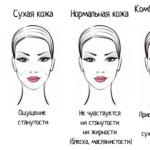- " onclick="window.open(this.href,"win2","status=no,toolbar=no,scrollbars=yes,titlebar=no,menubar=no,resizable=yes,width=640,height=480,directories =no,location=no"); return false;" > Print
14.06.2012 13:34
Many people think that making jewelry requires a lot of materials, time and knowledge, and even special tools. But you will need a minimum of materials to make elastic bracelets, that is, bracelets using an elastic cord.
Elastic threads are used to make bracelets, and a big advantage in creating such bracelets is that we do not need any special tools. Also, making bracelets with an elastic cord will take literally 10-15 minutes.
All we need are beads of various colors and shapes, and to add originality we can take pendants, rondels, caps for beads and other accessories for jewelry that you have on hand. Here, as they say, everything depends on the flight of your imagination.

For the bracelet, I decided to take a black elastic cord 0.8mm thick. By the way, regarding the thickness of the cords, if you want to use beads of a large diameter for a bracelet, then it is better to use a thicker cord, for example, 1 mm, and for small beads or bracelets for children, cords with a diameter of 0.6-0.8 mm are more suitable.
We did not reinvent the wheel and used the wonderful technology of stringing beads and tying a knot, which Tatyana Zakharchenko talked about in her article. So, we read:
First, determine the size of your wrist. This is especially true if you want the bracelet to fit tightly on your hand. Typically, the wrist sizes of different people lie in the range of 15-19 cm. In addition, keep in mind that the left and right wrist They differ in size; right-handers, as a rule, have a slightly thicker right hand. Therefore, it may well turn out that a bracelet made on left hand and he who sits well on it will put pressure on the right one. Not much, but after a few hours of wear it can cause discomfort. Of course, if you want to make a bracelet that dangles freely on your hand, these comments will not be relevant.

If the holes in the beads are wide enough, you can string them directly onto the thread. It’s more convenient (and faster) for me to use a needle and auxiliary thread, as shown in the photo below.

Place beads and beads on an elastic thread as you like. The length of the dialed section should be slightly larger than your wrist. Please note that a bracelet that is too narrow will squeeze your hand, and a bracelet that is too wide will dangle. However, you can deliberately make a loose bracelet.

When selecting beads, it is necessary to take into account the pattern repeat and the size of the largest beads.
In the photo, the yellow arrow indicates the wrist size, and the blue arrows indicate possible options for completing the set. I do not recommend making the bracelet smaller than your wrist - it will pinch, and after a few hours of wear there will be marks on the skin. It is always better to provide a small margin for a loose fit. Moreover, for small beads half a centimeter is enough, for large beads you may need even up to 2 centimeters - keep in mind that the final internal diameter of your bracelet directly depends on the size of the beads.

Once the beads are cast on, pinch the thread at the base of the beads and cut (do not stretch the thread!). You now have loose ponytails of about one and a half centimeters.

Now pull the thread and pull out the tails another centimeter and a half - two. This will be enough to make it convenient to tie a knot; the thread in the bracelet will be taut, but not too much. Tie a knot.
First half knot:

Since the thread must be taut when tying a knot, hold it tightly with your left hand, and with your right hand, circle it with a free tail as shown by the arrow (If you use the knot I recommend, then you will need to circle it twice, pressing the turns with the fingers of your left hand)
Second half knot. To make it more convenient, press the first half-knot with your middle finger.

Now about that How to tie an elastic thread?
The most important thing is don’t tie a “regular” woman’s knot - it won’t hold! You can tie a straight knot. But there is a better option.
For the first half-knot, wrap the thread not once, but twice - as shown in the photo:

Knit the second half knot as usual. Please note that it is knitted in a mirror image (“in the other direction”) relative to the first one (according to the principle of a straight knot).

The knot is in a tightened state. This is a surgical knot. This is the knot that surgeons use to connect threads together during operations.

And here is an example of an incorrectly tied surgical knot: the second half-knot is tied “in the same way” as the first:

When tightened, such a knot unfolds:

Choose a suitable base bracelet.
The first thing you need to start assembling a bracelet with charms is to buy a base. Most girls prefer the silver version. Now in stock jewelry You can find a wide variety of bracelets that can be used as the basis for charms. The most common types-
hard or semi-rigid bracelet.
- semi-rigid version with lace weaving with a snap clasp in the form of a ball or box. Many people prefer. Both fasteners are reliable and aesthetically pleasing, so the choice is up to personal preference.
Charms look stylish and elegant when worn on a thin . These are the bracelets that are in the Italian collection of silver jewelry, which are exclusively presented in SLAVIA chain stores. But when purchasing a rigid silver bracelet, you need to be clearly sure of its size: the pendants additionally “eat up” a little space, so the bracelet itself should fit freely on your hand. This rule applies to closed bracelets - such questions do not arise.
You can assemble a beautiful bracelet using a leather base or textile cord. available in stock jewelry stores SLAVIA.
There are several advantages to choosing such a bracelet. Firstly, its cost is much lower than silver. Secondly, this the best option for summer. Light outfits and beachwear harmonize best with natural materials: leather, wood, stones, textiles... Thirdly, this option is suitable for those who are just starting to collect their collection of charms, because... Even one charm will look beautiful on a leather bracelet. Fourthly, a leather bracelet looks impressive in combination with silver bracelets and watches. This is very convenient for those who prefer multi-layered jewelry when choosing jewelry.Fifthly, a leather bracelet with charms fixes the charms more reliably, so it does not require additional stoppers (pendants that snap onto a certain section of the bracelet and hold the beads in a certain sector).
If you choose a leather or textile bracelet, you should keep in mind that you should not hang more than 7 charms on such a base.

DefineFind the correct base size
- Chapter 2. Types of charm pendants and rules for their selection.
1. - this is a simple or voluminous ring made of silver, to which a figurine or symbol can be attached. Charms also include figurine beads without such a ring, which are placed directly on the base. Charms also include colored Murano glass beads.

2. Stoppers and clips – pendants that snap onto a specific area of the bracelet. Such elements usually divide the bracelet into several sectors and hold the beads in a certain area.

3. Separators- small silver beads that separate charms from each other, balancing the composition.

4. – these are two identical clips connected to each other by a chain. They are placed on both sides of the clasp so that if the bracelet accidentally comes unfastened, the beads do not fall apart.

5.
Pavé beads- ordinary charms, completely inlaid with a scattering of stones.

How to assemble: some rules for choosing pendants
1. In order to assemble a laconic piece of jewelry with a universal style, it is recommended to choose round beads made of silver.
2. Do not overload the bracelet with pendants different styles. There must be some kind of semantic connection between the beads on the base; they can be similar in shape and color.
3. To prevent the charms from merging into one silver mass, they should be separated from each other by murankas or brighter charms.
4. Two bracelets with a small amount of silver charms look beautiful and stylish on your hand. One of them may be leather.
5.
Pavé beads are distinguished by their effectiveness and brightness. But there should not be more than 2-3 such pendants on the bracelet.
6. Many girls choose silver charms for their bracelets, which contain some specific meaning. For example, young mothers, for whom the birth of a child has become the most important event in their lives, hang a stroller charm or a charm with a girl/boy on their bracelet. Ladies who are interested in some hobby decorate the bracelet with charms in the form of a camera, a dancing couple, a sports ball, a theater mask, a silver watering can, etc. Girls in love love to decorate the bracelet with charms in the shape of hearts. Romantic people like the fairy-tale style of bracelets, which is given to them by castle charms, pendants in the form of fairy-tale characters and mythical heroes.

Of course, there is no exact and universal answer to the question of how best to assemble a bracelet.
with charms, no. After all, it depends on the character, temperament, age and
appearance of the owner of such an accessory.
In any case, you need to remember that a charm strung on a bracelet with certain emotions and thoughts can become a real talisman of good luck. Therefore, you need to start assembling a bracelet with the brightest feelings and in no case be upset if you didn’t quite succeed in combining some kind of pendant. After all, extra charm is a great reason to buy another foundation for yourself or give a nice gift. best friend, who is also still looking for an answer to the question of how to assemble her own bracelet that brings happiness and good luck.
The easiest way to assemble a bracelet is to assemble it with an elastic band. Use a strong and reliable thread for this. If the thread is thin and stretches too much (and if you're just worried about it fraying), fold it several times. Usually two or three layers of thin thread easily fit into the hole of the beads.
For bracelets with elastic better NOT to use heavy beads (large, made of glass or natural gems). For obvious reasons, beads with sharp edges of holes are also not suitable. For such bracelets, it is better to take a jewelry cable. No knots are tied on it, but working with it has its own specifics. A detailed master class on how to make bracelets on a jewelry cable.
Let's return to elastic bracelets. Preferences in choosing beads have already been discussed. Now about the elastic band. I use (code in our catalog 351-011). It is soft, so you will need another needle. If your thread is thinner, use several plies of it. We select any suitable beads and decorative elements. I have metal cast caps and crystal translucent beads. More polymer clay beads made using the mokume-gane technique.
I string beads onto a thread. To make it easier to thread the needle into the eye, I melt the edge of the thread a little; when melted, no solid drop remains on this thread, but the fibers become more ordered.

I tie the ends of the thread in a knot, the bracelet is ready. Read more about nodes below.

For securing synthetic threads, elastic, spandex and fishing line better use the following nodes:
Surgical knot

Look like him Academic node.

Also reliable Flemish knot.

Another knot that is very difficult to untie is Water node. Also suitable for elastic.

Also good for fishing line and synthetics Furrier's knot.

Great fit Liana knot.

These knots are all well suited for jewelry, but have different sizes, volumes and patterns. If this is not important for the thin thread that I use, then for a round thick elastic band or waxed cord it can be important, so before making the product, it is better to practice on a piece of thread.
A very useful knot not only for bracelets, but also for hanging simple pendants is the so-called SLIDING knot. It allows you to make the bracelet adjustable in length without using a special clasp.

And one more option, which is used in Shambhala bracelets. For such a sliding knot, an additional third piece of cord is needed, which fixes the sliding point. This bracelet is regulated by the tension of the waxed cord warp threads.

Now a few words about the nodes that should not be used:
Oak knot don't come near t for securing synthetic threads and fishing line. When pulled, it slides and comes undone easily.

Also not suitable Babi knot, although it is so common in everyday life. This is how shoelaces are usually tied, but such a knot will not be able to hold the elastic at all.

Just as insidious Mother-in-law's knot, also not for our purposes.

Weaving knots They fit well on threads, but they slip on the elastic band.

The drawings and descriptions of the properties of the knots were taken from L.N. Skryagin’s book “Sea Knots” and were tested by me practically on an elastic band.
Here are some more photos of bracelets as an example. Using different fittings and beads, we can change the style of the bracelet.
This bracelet uses crystal beads of different sizes, a shaped spacer bead, bead caps, a pendant holder, a connecting ring and a sparkle pendant.

This work includes Natasha Beads resin beads, crystal beads, bead caps and spiral spacer beads.

These simple bracelets have minimal details. Striped resin beads and wooden beads. With purple beads I used 6 mm uncut glass beads.

Bracelet with a rose pendant, crystal beads, polymer beads decorated with caps for jewelry. The rosette is attached to the bail using a connecting ring.

To complete the collection, I will add a link to another master class. How to stretch an elastic band inside a long hollow tube. Follow the link for description. Briefly, a loop of jewelry cable or wire is inserted inside the bracelet, a soft elastic band is hooked into it, and when the cable is pulled out, the rubber band is also removed from the other side.

Good luck and creative mood! I hope that you will get the most beautiful and reliable bracelets!
One of the most common accessories that express your sense of style and knowledge of fashion is a bracelet. His right choice can radically change your image or simply add the necessary accents. To do this, you just need to decide on the color and shape of this accessory that will suit you. And so that you have a suitable bracelet, you can simply make it yourself and not spend a huge amount of time looking for it. In this lesson I will show you how to make bracelets with your own hands from threads, from beads and beads, from rubber bands, as well as simple bracelets for beginners with step-by-step photographs.
Nowadays, any fashionista has many accessories in her wardrobe, but only those that are created with her own hands are priceless and original.
Bracelet made of beads and cord
Young fashionistas may need a lot of jewelry. After all, they want to change them almost every day. And you don’t have to go to the store to do this. You can make many decorations yourself, using quite inexpensive materials. This is exactly what our bracelet is, made of cord and beads. With him step by step production can be found in this master class based on the photographs presented.

To create such a bracelet we will need:
- beads;
- braided cord (100% polyester);
- elastic thread;
- scissors;
- needle;
- lighter.

It is important to use synthetic cord. Cotton material is not suitable for such a bracelet, since during the work you will need to melt its ends, and this can only be done with synthetic material.
Having previously melted the tip of the cord, insert a needle with an elastic thread, retreating approximately 2 cm from the edge.

After this we put on the bead.

Then we make a small bend in the cord, after which we insert a needle into it.

We make a symmetrical bend of the cord of exactly the same size, and then put on the bead.

Using this principle, we continue to assemble our bracelet to the desired length.

Having finished assembling, tie the ends of the elastic thread.

Cut the ends of this thread. The yellow cord also needs to be shortened, so we cut off the free end, leaving about 4 cm.

Now you need to align the two ends of the braided yellow cord. To do this, we measure their length more accurately, so that when they are combined, a bend of the desired size can be obtained. After this we shorten the cord.

Take a lighter and melt both ends of the yellow cord. After that, we quickly connect them together. Our cord was shorted.

A DIY bracelet made of beads and cord is ready.

A young fashionista will surely like this decoration.

How to make a bracelet from “Friendship” threads
Strong friendship is a gift of fate. Find the real one true friend Not everyone succeeds. Let's make bracelets to give to our friends. The friendship bracelet is popular among teenagers; it is believed that the friendship between friends will be as strong as the knots on the bracelet. There are many types, it can be made from rubber bands and floss, but we will make it from knitting threads. That is why our bracelet is so voluminous and massive.

To work, we will need thick knitting threads of contrasting colors and scissors.

For our bracelet we chose yellow and Blue colour. Firstly, contrasting colors go well together, secondly, young people love bright colors and, thirdly, the meaning of colors. Yellow is the color of freedom and good luck, and blue is the color of peace and harmony.
Making a “Friendship” bracelet with your own hands
Tie the ends of the threads.

Make a loop from the yellow thread.

Throw the blue thread over the yellow loop.

Form a loop with blue thread.

Thread the blue loop into the yellow one.

Tighten the yellow loop.

Form a loop again using the yellow thread.

Thread it through the blue loop.

Pull the blue thread, tightening the loop.

Continue weaving, threading the loops into each other.




To complete the bracelet, cut both strands. 
Pass the cut thread through the last stitch. Tighten it.

Tie both threads.

The “Friendship” bracelet is ready. All that remains is to tie the ends of the threads.



How to make bracelets for men with your own hands
How to knit a broomstick bracelet with elongated loops
Accessories are what emphasize our style and uniqueness. And accessories created by yourself will make the image bright and original! In this tutorial we will crochet a brumstick bracelet using elongated loops.

For knitting we need:
- Emerald colored yarn;
- Hook 1.75 mm;
- Scissors;
- Ruler;
- 2 beads in a yarn-like color.
We collect 11 air loops. And we will make 1 more loop for lifting.
We go back and knit 1 row, consisting of sc.

Repeat the row 1 more time to form a place for the fastener.
Now we carefully pull out the last loop and put it on the ruler.

We crochet into the same loop from which the loop on the ruler comes. We pull the working thread through it and also put it on the ruler.

We should end up with 12 loops on our line.

Now we will divide 12 loops into 2 groups of 6 loops. We pass the hook under the first group.

Transfer the loops from the ruler to the hook.

And we knit 1 air loop through all the loops on the hook.

Through the same loops we knit another 6 sc.

Now we transfer the 2nd group of loops from the ruler to the hook.
We pull the working thread through them and knit 2 loops on the hook in one fell swoop.

We knit another 5 sc in the middle. That is, the same as last time.

We pull the loop from the hook and put it on the ruler.
Now we pass the hook into the next loop of the base and form an elongated loop on the ruler. The same as they did before. As a result, there will again be 12 loops on the ruler.

Next, knitting is repeated. Transfer 6 loops to the hook again. We secure them with an air loop and perform 6 sc. Then we transfer the remaining 6 loops, first knit only the elongated loops, and then all the loops on the hook. We make 5 sc under the elongated loops.

And we start all over again.
So we will knit the required number of rows. We take into account that at the end you need to leave room for forming loops.
At the end we knit 12 sc. We make 1 air loop and turn around.
We knit 3 sc. We make 4 air loops. We skip 3 loops and perform 1 sc in the 4th.
We perform 3 more air loops. We make 4 air loops again and skip 3 loops again. Next we tie the sc to the end.
On the other side of the bracelet we sew 2 beads.


The crochet brumstick bracelet is ready!


Rubber band bracelet for beginners
Weaving with multi-colored elastic bands is becoming very popular. This type of work does not cause much difficulty. We will conduct a lesson on weaving a “Rainbow” bracelet.

To do this, you will need a special machine, elastic bands of different colors: red, pink, blue, blue, green, light green, yellow, orange.

We put a red elastic band on the posts of the machine in a figure eight pattern. On top of it we put the same elastic band without the figure eight.

We take the edges of the lower elastic band one by one and lower them into the middle. The bottom elastic band takes the shape of a figure eight.


After using all the colors for the first time, repeat them again.

Having finished weaving the bracelet, remove the loops in the middle and attach a clip to the last loop.

We connect the bracelet with a clip on both sides.

The rubber bracelet is ready to use. It can be worn as a decoration. This weaving method is becoming very popular.
Rubber bracelets have long been popular among children and adults. And in this master class, we will weave a simple, but beautiful and bright bracelet.

To weave such a bracelet from rubber bands, we need:
- Green and Pink colour;
- Slingshot;
- Hook;
- Clasp.
To weave such a bracelet, we need a slingshot. But if it is not there, then you can make it yourself from improvised materials. You can take 2 pencils and an eraser. We put the eraser between the pencils and wrap it with tape.
Now let's start weaving. We take a green elastic band and a slingshot. We throw the rubber band on one side of the slingshot, cross it and throw it in this position on the second part of the slingshot.
That is, the rubber band should form a figure eight and cross between the slingshot posts.

We put on a pink elastic band simply, do not cross.

We don’t take anything off, but put on another green rubber band on top.

So we have 3 rubber bands on each column. 2 of them are green and 1 pink in between.
Place the hook under the lowest elastic band and pull it back, hooking it.

Drag it across the column.

And let go between the columns.
From the 2nd column we also throw the bottom elastic band over.

So we started the bracelet. We will then attach the fastener to this rubber band, which is now located between the columns.
Now we need to take a pink rubber band and put it on both columns at once.

We still have 3 rubber bands on the columns. But now 2 are pink and 1 is green.
We grab the bottom pink elastic band with a hook and pull it out. In the same way as before, we throw it to the center. We do this on both columns.

We put on the green rubber band again. And now we repeat the action. This is how we will knit constantly. That is, we will put on 1 rubber band at a time, alternating its color. Each time after putting on the elastic band, we throw the lowest elastic band into the center of both columns.

We need to weave this way until our bracelet reaches the required length for the wrist.

In the last row, after we have thrown off the bottom elastic band, we still have 2 elastic bands left on the columns. We remove the bottom one. There is 1 rubber band left on the columns. It needs to be transferred to the hook.

And now we place 1 part of the rubber band under the other and tighten the resulting knot.

We thread the resulting loop into the clasp. Now we find the very first rubber band that we removed, on the other end of the bracelet. We thread it through the 2nd end of the fastener.
The rubber band bracelet on the slingshot is ready! It can be decorated with wicker berries or flowers.



How to make an accessory using the quilling technique
How to make such an accessory using technology - detailed master class see here.





In this tutorial I will show you how to knit such a bracelet from waxed cord.

We only need a waxed sectional dyeing cord - 2.5 meters.

Cut the cord into 2 parts - 2 meters and 0.5 meters. Fold the cords in half.

Place the short cord in the center. Place the long cord along the edges. Make a chain of flat macrame knots. Knit the first knot according to the pattern - left end up. Knit the second knot in reverse - the right end is up.


Finish by tying all the threads together, back off a little, and repeat. Despite the ease of implementation, the bracelet looks impressive.

Elastic bracelets are perhaps the easiest to make. Here you can certainly use various materials: acrylic, glass, wood, stone, polymer clay, metal. It is also possible to combine these materials and combine different shapes, colors and textures. In this master class we will make a bracelet with an elastic band from coral.
We will need:
. Stretchable silicone thread red 0.8mm
Coral beads diameter 14mm (10pcs)
Golden metal balls with a diameter of 3mm (9 pcs)
Butterfly pendant 17×16mm gold
Detachable gold rings (2 pieces)
Bale 12?7mm golden
scissors
First of all, let's prepare the pendant. To do this, we connect 2 detachable rings to each other and hook one ring to the pendant hole, and the second to the bail.


Next, measure the thread according to your hand and cut it with a margin for the knot. We cut the thread 25cm long. We begin to string beads, alternating with metal balls. Having reached the middle of the bracelet (after the 5th bead), we string the bail with the pendant and continue stringing the remaining beads.


When all the beads are strung, we tie a knot: you need to tie two regular knots and a third on top of two. The knot should not slide when tensioned. We cut off the excess ends. If necessary, the knot and tails can be coated with a little glue and allowed to dry. If the hole in the bead allows, the knot will easily “hide” in the bead.

An elastic bracelet should not fit tightly around your wrist. When putting it on, the thread should not stretch too much, otherwise the bracelet may break. To avoid this, measure the length of the thread correctly. Take your time to cut the thread quickly, and before tying, try on the bracelet on your wrist. Cut the thread and tie it when you are sure it is your size. Just a few minutes and our charming bracelet is ready!

Creating elastic bracelets is an unlimited field for realizing countless fantasies! Try creating your own unique elastic bracelets. They can be very diverse: with metal pendants and with acrylic pendants; performed in one color scheme or multicolor; made of natural stone, glass, clay or acrylic; or maybe it will be a whole series of bracelets made in the same style?! Happy creations!





